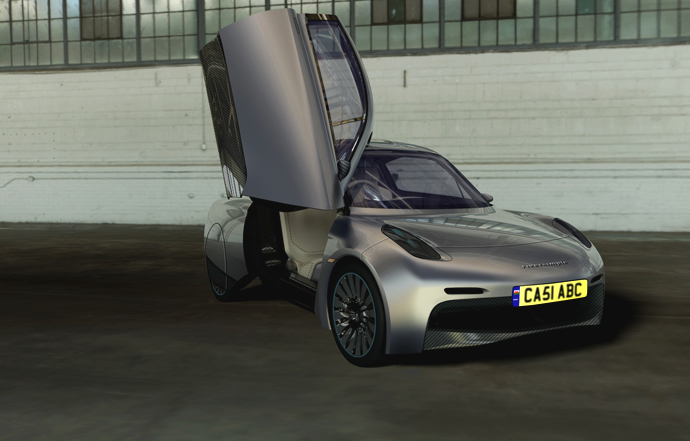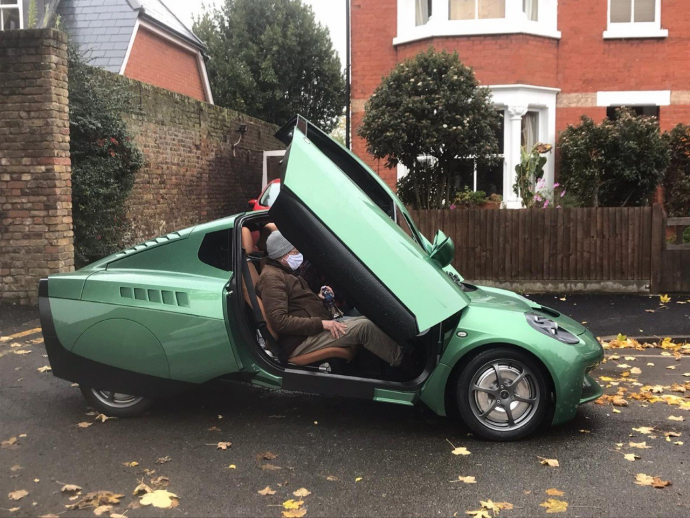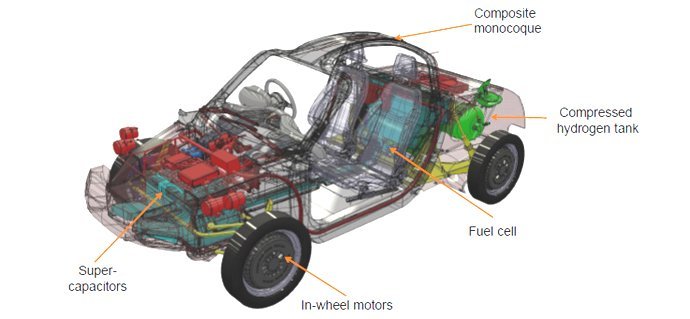
The internal combustion engine has done an admirable job at resisting obsolescence – even in the face of climate breakdown, an air pollution crisis and widespread cheating of emissions testing, car makers are reluctant to start with a blank sheet of paper. However, there are signs the death knell is tolling for the internal combustion with the announcement by various countries including France that petrol and diesel vehicles are to be banned.
The Riversimple Rasa is a hydrogen car that aims to radically change the way we think of personal transport; an affordable, hassle free, fun-to-drive eco car. Under the French plan, those without the means to buy a clean vehicle will receive a grant, but the Rasa is never owned outright. Instead, it is leased like a mobile phone.
Tabula Rasa means ‘clean slate’ in Latin. It’s an apt name for the new Riversimple car, a vehicle that redefines personal transport in our age of increasing population and diminishing natural resources. Every aspect of the Rasa has been created for simplicity, efficiency, lightness, strength, affordability, safety and sustainability.
In some respects, the Rasa can be likened to the Citroen 2CV, the iconic workhorse of post-war France. The two cars share a purpose of design, top speed of 60 mph and a weight of around 580 kg, but the Rasa is very much a car for today. Its chassis is a monocoque made from very stiff carbon fibre composites and yet weighs less than 40kg.

The Rasa visiting Weybridge this week
Weight distribution is even thanks to four electric motors, one in each wheel. The motors double up as brakes – recovering over 50% of kinetic energy when braking. Super-capacitors store this energy and provide most of the power for acceleration.

The production prototype should do the equivalent of 250 mpg with a range of 300 miles. Emissions are zero at tailpipe and around 40 gCO2/km if the hydrogen comes from natural gas.
Very few mobile phone users buy their handset upfront. Most of us spread the cost over the term of the contract. It’s a model that the makers of the Rasa aim to apply to motorists wanting to use a hydrogen car; they will retain ownership of the cars and sell mobility as a service.
Rather than buying the hydrogen car outright or having to set up a hire purchase agreement, a simple pricing structure enables customers to pay a single monthly fee that covers everything – the car, the maintenance, the insurance, the fuel. The rationale is that customers have all the pleasure but none of the hassle of ownership. From the manufacturer’s perspective, it pays to make a car that lasts as long, and runs as well, as possible.
More at riversimple.com
How does a hydrogen car work?
Hydrogen can be used as a fuel for electric cars thereby doing away with the need for a battery – the car does not have an engine in the conventional sense as it uses instead a fuel cell stack, a device that uses an electrochemical reaction between hydrogen and oxygen to produce electricity to power a motor. These so-called fuel cell vehicles can travel longer distances than electric vehicles that need to be re-charged directly from a mains supply.
At an early stage, the Riversimple venture was backed by Sebastian Piech, a great-grandson of Ferdinand Porsche, who in 1898 worked on the Lohner Electric Chaise – one of the world’s earliest electric cars. The Lohner car had a top speed of 31 mph and a maximum range of 30 miles.
ETA: Ethical breakdown cover
Established over 30 years ago, and with over 5,000 recovery trucks on call 24/7, the ETA has a proven track record of providing efficient, reliable breakdown cover. We handpick only the best local mechanics and garages around Britain to send out if you break down. We believe this way of working is efficient, environmentally friendly and helps support local communities and economies, too.
Not only are we judged to be Britain’s most ethical provider by The Good Shopping Guide, we campaign for sustainable transport. Supporting this work is easy – you simply have to take out insurance with us. We provide home insurance, cycle insurance, travel insurance and breakdown cover – all while putting concern for the environment at the heart of all we do.
Peter Szczesiak
This “car” is a total and utter waste is time and money! Hydrogen for cars is to energy heavy to make, along with being highly flammable it also likes to crack metals! Batteries are safer allow home refueling and cost less than this attempt at a car
Anthony Warren
Just wondering if Peter Szcesiak has something to do with vested interests. Nay-saying is always easy but there are solutions to all the technical difficulties. Toyota’s new Mirai hydrogen tanks are laminated carbon fibre with a plastic (hydrogen-proof) inner layer and hard fibreglass shell. The real positive is that H2 power doesn’t involve nearly as many toxic chemical processes as battery manufacture.
We need political pressure to roll out the H2 infrastructure faster.
Christopher Dale
I have visited this factory and was impressed by the enthusiasm of the staff. The idea of hydrogen as a source of energy will soon be easy to sell, the idea of only renting a vehicle is another thing but we could get used to it. The compny is very tiny but their ambitions are huge, I’ve seen the car, it’s brilliant and I do wish them all the best.
One large problem they will come across will be the availability of hydrogen filling stations. Shell and ITM, who make the kit, do have plans but so far as I can see the government is only half committed to the idea.